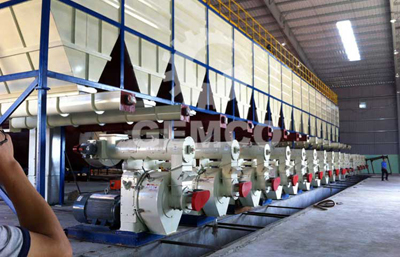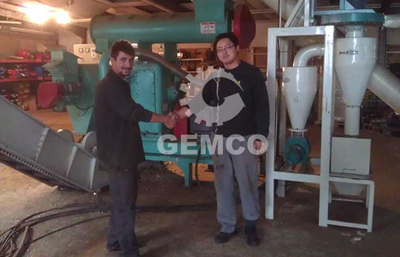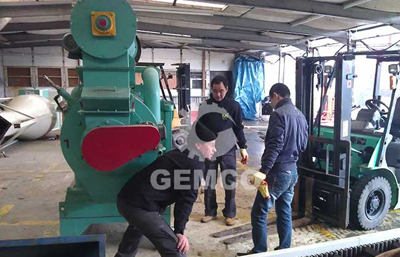make biomass pellets
Biomass has low bulk density, making it difficult and costly to store and transport in its native loose form. Therefore, a new trend of making them into biomass pellets is more and more popular. After you know why make biomass pellet and how to make wood pellets, it is also very important to pay attention to the things that you should notice about making biomass pellets, or you may experience a lot of wasted time and money with a lot of frustration.
During the pellets making process, the significance of major contributing factors (independent variables such as biomass type, treatment, pressure and grind size) on pellet density, durability and specific energy were determined. Poor quality pellets can crumble to biomass powders, or produce more ash, but if you keep the following things in heart, you can save lots of trouble and get high quality biomass pellets.
Biomass Pellets’ Raw Material Size Reduction
Before being compressed in pellet mill, the raw materials must be reduced in size, because only a raw material of consistent quality can produce consistent quality pellets. Particles of raw materials must have suitable size. If these particles are too small or too large, the final pellets’ quality can be severally affected, and consequently, the energy consumption will be increased.
Researches have shown that the type of biomass (47.1%) is the most significant factor affecting durability followed by the application of pre-treatment (38.2%) and grind size (14.6%) for pellets manufactured using the pilot-scale pellet mill.
Biomass Pellets’ Raw Material Moisture Content
The moisture content of biomass pellets’ raw materials must be proper, or the final pellets’ combustion value can be very low. Usually, biomass pellets’ moisture content is below 10%, which ensures that biomas pellets burn very efficiently, and produce virtually no smoke during combustion. Studies have also shown a raw material with moisture content 1% away from the ideal can force the pellet mill to use up to 20% more power per ton during production. Hence accurate moisture control is also crucial to keep energy costs to a minimum. The right and proper moisture content will help to produce the best quality pellets, reduce energy consumption and reduce pellet mill downtime.
Add Binders or Lubriants into Raw Materials
Sometimes, you need to add binders at specific percentages and lubricants to reduce the load on the pellet mill motor to help the raw material make quality pellets.
In the conditioning of raw material, you should mix them thoroughly and evenly. Sometimes, you also need to add some water or steam to pre-anneal the raw material and start the lignin melting process. And, generally for wood pellet production, binders or lubriants are added to make pellets form more easily.
Raw Materials’Feed Rate in Pellet Mill
Another adjustment that is not well known to impact on pellet production is the rate of feed into the pellet mill. Adjustments on feed rate and maintaining a consistent feed rate can be the key difference to how well the pellet mill operates, even if the raw material is perfectly prepared.
Operating Temperature in Pellet Mill
Temperature is a key factor in biomass pellets production. Unless a certain temperature is reached in the pellet mill natural lignin will not melt. It is not possible to produce some biomass pellets for example wood pellets without sufficient heat. However, if the temperature is too high this can damage the pellet mill and particular consumables such as the pellet mill die, rollers, bearings and seals.
Operating Pressure in Pellet Mill
It has been found that applied pressure (60.4%) is the most significant factor affecting pellet density followed by the application of steam explosion pre-treatment (39.4%) for lab-scale single pelleting experiments. Also, applied pressure (58.3%) was the most significant factor affecting specific energy required to manufacture pellets followed by the biomass (15.3%), pre-treatment (13.3%) and grind size (13.2%), which had lower but similar effect on specific energy for lab-scale single pelleting experiments.
Distance Between Pellet Mill’s Roller and Die
Another adjustment that can impact heavily on how successfully the pellet mill operates is the distance between the roller and die of pellet mill. The roller and die are wearing consumable parts, due to the abrasive nature and pressure of compression. The distance set between the roller and die can impact on how much energy the pellet mill uses, pellet’s quality, pellet mill productivity and the amount of fines produced. Correctly setting up the die on a pellet mill will also increase the life of the roller and die, and reduce the cost of changing these consumable parts.
Rotation Speed of Pellet Mill’s Roller and Die
The speed at which the roller and die turn affect the complex relationships during pellet compression. Some raw materials require longer time under compression, and therefore require a slower rotation speed. Also, the speed and torque requirements of the pellet mill change. You can turn to GEMCO’s technicians or after-sales service expert for specific guidance.
Design and Metal Used of Pellet Mill’s Die
Many different forms of metal alloy are used to produce pellet mill die templates. Different metal alloys have specific advantages and disadvantages. Using the correct alloy is critical to reduce wear and increase production. The type of metal used also affects the finish of the die holes. GEMCO customize the dies of pellet mill for customers to make sure that they get pellets with high quality and minimum abrasion.
Last but not least, stalling the motor is very possible without good awareness. Even with a raw material mixed and prepared correctly the pellet mill still needs to be set-up and prepared correctly or quality pellets cannot be produced. Just some of the aspects of setting up a pellet mill correctly are the roller and die rotation speed, the distance between the die and roller and proper conditioning of the die template to make good product flow with good compression at the same time.
We receive enquiries in English, Español (Spanish), Русский язык (Russian), Français (French) and العربية (Arabic). Our professional team will reply to you within one business day. Please feel free to contact us!




